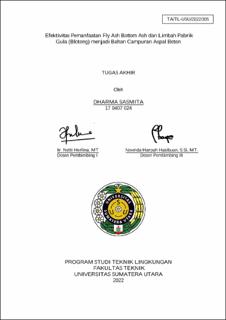| dc.description.abstract | The environment’s quality degradation has an impact on the lives of living things, so
environmental protection and management are needed. One way to improve
environmental quality is by utilizing industrial waste. Industries that produce a lot of
waste and minimally process it includes sugar factories, textile factories, and power
plants. ‘Blotong’ as sugar factory waste causes pollution to the environment. Fly ash
and bottom ash, the coal combustion waste, have the potential to harm the environment
and also human health. This study is conducted to determine the feasibility of the
asphalt concrete’s quality to reach the optimum point by changing filler to fly ash,
bottom ash, and ‘blotong’ with variation I (FABA 30%+Blotong70%), variation II
(FABA 50%+Blotong50%), and variation III (FABA 70%+Blotong30%). This research
method uses the Marshall Method following to the Bina Marga Specification in 2018
Revision III. The results show that the optimum asphalt content obtained by each filler
variation is as follows: Variation I (6.35%), Variation II (6%), and Variation III
(5.85%). Furthermore, the test values of all parameters are described as follows:
stability values, VIM, VMA, VFB, and Marshall Quotient in all filler variations met the
specifications, but in flow values with a mixture of variation II and the remaining
Marshall stability values in variation I did not meet the specifications. This shows that
the asphalt content and the addition of blotong used affect the deterioration of the
asphalt concrete mixture’s quality. The results of the one-way anova data analysis
illustrate that VIM and VFB values do not have a significant relation with filler
variations and several Marshall parameters. | en_US |

